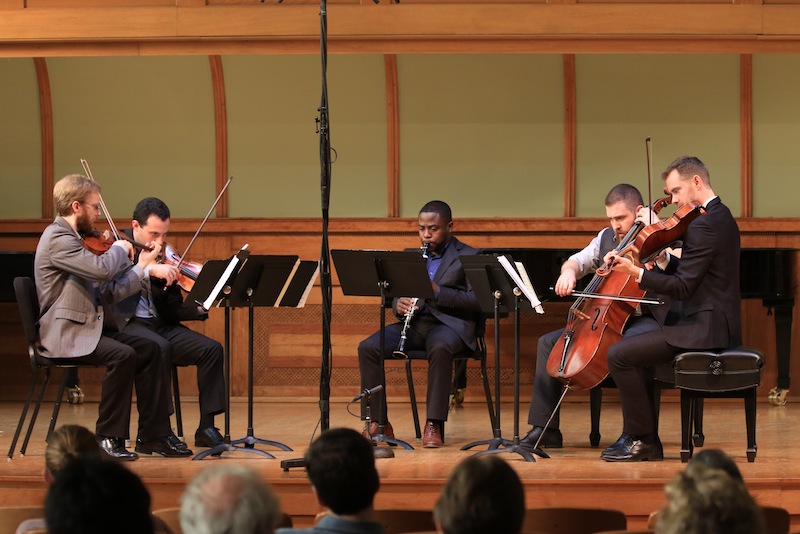JACK Quartet and McGill bring fire to edgy American Music Project program

Much contemporary classical music remains difficult for many listeners because it so often takes away the elements we are accustomed to relying on to make sense of music, such as comprehensible chord progressions, tuneful melodies, and clear structures. With these elements absent, composers and performers must squeeze maximal expressive power from the remaining elements—dynamics, sonority, etc.— to communicate with their audiences.
The JACK Quartet faced this challenge at the concert they gave Sunday afternoon at Roosevelt University’s Ganz Hall, presented by the American Music Project. And the New York-based ensemble consistently met this challenge well.
The program began with The Wind in High Places by John Luther Adams. Here, the missing elements are most of the pitches producible on the instruments, as Adams calls for only the notes of the open strings and their natural harmonics. The empty space between these notes lends the music its starkness.
The piece could easily have turned shapeless, wafting without direction or differentiation. But JACK Quartet expertly shaded their dynamics and timbre. The wind moved in waves of color and intensity, while maintaining a basic piercing coolness.
The second piece was Earle Brown’s String Quartet. It is a piece of “indeterminate” music: the performers assemble the final form of each moment of the piece from the composer’s open-ended instructions.
Instead of pure chaos (always a distinct possibility), JACK Quartet produced something closer to sound pictures. Perhaps it was the juxtaposition of this with the Adams that made it also feel meteorological. Its opening minutes were like gray mist giving way to acerbic raindrops, before at last a melody (phrased too like it was a genuine melody) emerged.
The third piece was John Cage’s Quartet in Four Parts. For this piece, JACK Quartet’s most effective choice was in distinguishing the character of the first two movements from those of the second two. They resisted playing the former two very dryly, as is common. There was palpable emotion in their playing, even without vibrato. But they played the expansive third movement “Nearly Stationary” (the longest in the quartet) almost expressionlessly; and paradoxically, the contrast of this austerity with all that came before is what made it expressive. The players were wise enough not to interfere with the finale’s disarming simplicity.
The final piece on the program was the Chicago premiere of Geoffrey Gordon’s Clarinet Quintet, for which JACK was joined by Anthony McGill, principal clarinetist of the New York Philharmonic. This piece–commissioned by the Chicago-based foundation–does not have the “stripped down” aesthetic of the others. Sonorities are fuller, gestures are clearer. This was the most emotionally generous music of the afternoon, and was therefore well placed at the end of the program, which would have felt too somber without it.
The key to the success of the performance by McGill and JACK Quartet was mitigating the piece’s persistence. In the first, second, and fourth movements, Gordon relies heavily upon a particular mode of interaction between the instruments: the strings building a chord one note at a time, working against trilling in the clarinet. Only in the third movement did the clarinet feel like it had room to “converse” freely with individual members of the quartet.
There was a large onus on McGill to make sure constant trilling did not become monotonous. He did this by continually varying the sound of the trills: the degree of initial attack, the tone color, and its dynamic trajectory. If future performances of this piece bring the same energy and commitment, it should become a welcome addition to the clarinet quintet repertoire.
Posted in Performances




